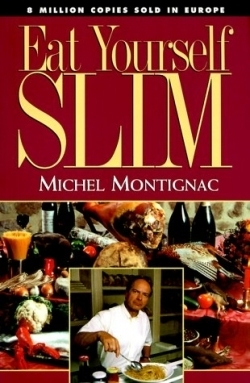It looks like you've stumbled upon a page meant to be read by our code instead of viewed directly. You're probably looking for this page.
Eat Yourself Slim
Modifying our eating habits often means first recognizing, and then modifying, a wide gamut of social behaviors: the vessels we eat from, the company we keep, the way we celebrate. Eat Yourself Slim takes this principle to a new level. Originally published several years ago in France, le Methode Montignac is the author’s plan to combat creeping obesity among his copains.
He starts by noting that until fifty or so years ago, Western cultures had fairly similar food habits and little obesity. In the intervening years, overeating has become more problematic, particularly in the United States. Montignac notes smugly that the French have had the lowest incidence of obesity of all Western cultures because they have held on to their traditional diet rather than succumbing to the fast-food influences of other (read: American) cultures. Obesity in France has been increasing nevertheless over the last twenty years.
But how do you promote weight loss in a culture that revels in eating and drinking? By telling your readers that they will still be able to drink wine and beer and eat generous helpings of food. Montignac, like American Zone guru Barry Sears, rejects calorie counting in favor of conscious combinations. When you eat (or drink) and what you eat with what is at least as important as what you are consuming. A glass of wine may be fine after dinner, but not with the meal, for example, and an apple is best enjoyed all by itself as a midmorning snack, rather than as part of lunch. And having a significant proportion of fiber in your meal will affect how your body absorbs the fats in your meal.
Montignac maintains that the conventional French diet promotes hyperglycemia, which in turn can develop into hyperinsulinism—the precursor to both obesity and Type II diabetes. Accordingly, the key nutritional principles in this book appear very similar to diabetic maintenance guidelines. A high-carbohydrate plan is set out, with “good” carbohydrates (having a low glycemic index) distinguished from the “bad” ones that are metabolized as sugars. Consumption of legumes and unrefined starches is encouraged. In addition, for readers who need to reduce cholesterol levels as well as lose weight, a chart of “good” and “bad” fats is provided.
Appendices to the book include an exhaustive bibliography, a list of other works by the author and a list of specialty foods sold under the author’s license. The handful of recipes in the back of the book interprets traditional French bistro fare according to these principles. There are several Montignac cookbooks available in France, so recipes are not the focus in this book.
Montignac has no formal scientific or medical credentials. He was a pharmaceutical company executive before he became a one-man diet industry. This text is full of polysyllabic, very official-sounding language. At least in its English translation, it purports to be serious material, and it may be heavy sledding for many readers who just want to know how to lose weight, and never mind the theory. It will be interesting to see what American health professionals make of this blueprint for healthy eating.
Reviewed by
Laurene Sorensen
Disclosure: This article is not an endorsement, but a review. The publisher of this book provided free copies of the book to have their book reviewed by a professional reviewer. No fee was paid by the publisher for this review. Foreword Reviews only recommends books that we love. Foreword Magazine, Inc. is disclosing this in accordance with the Federal Trade Commission’s 16 CFR, Part 255.
